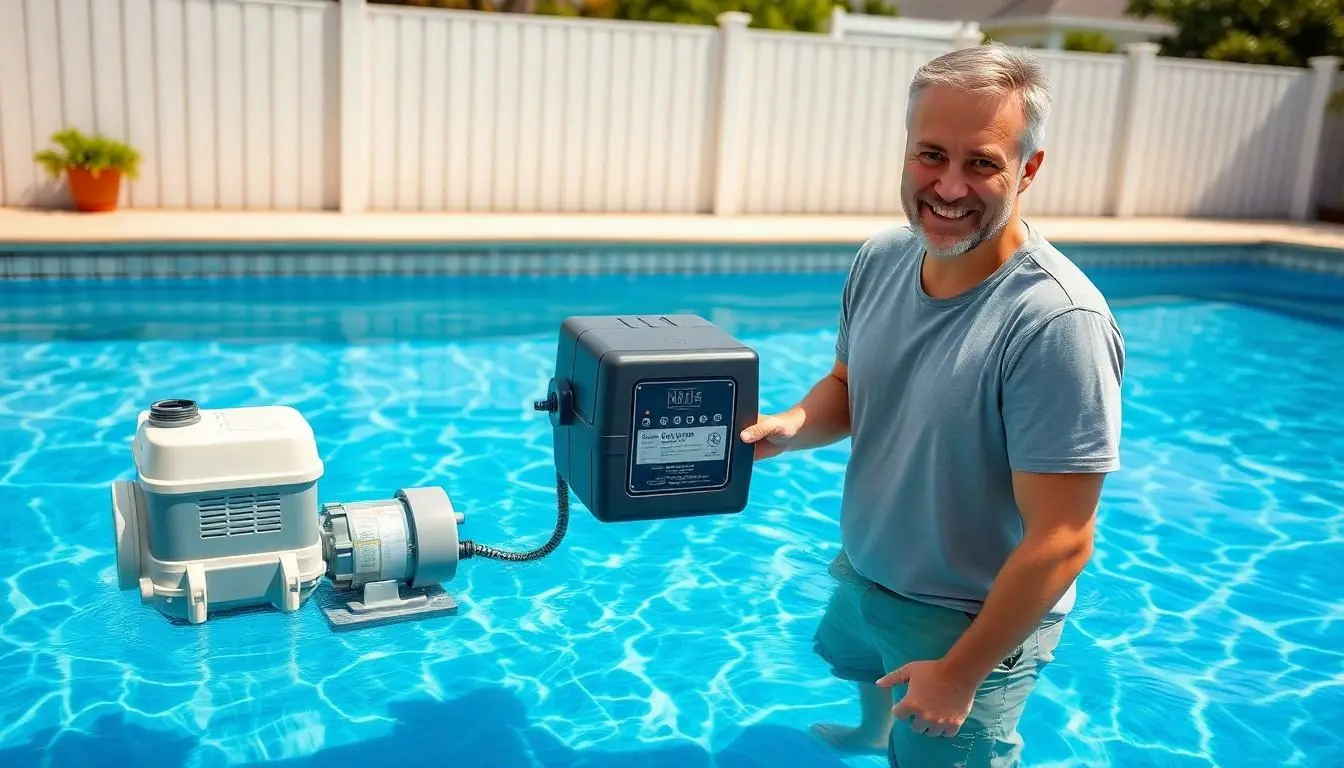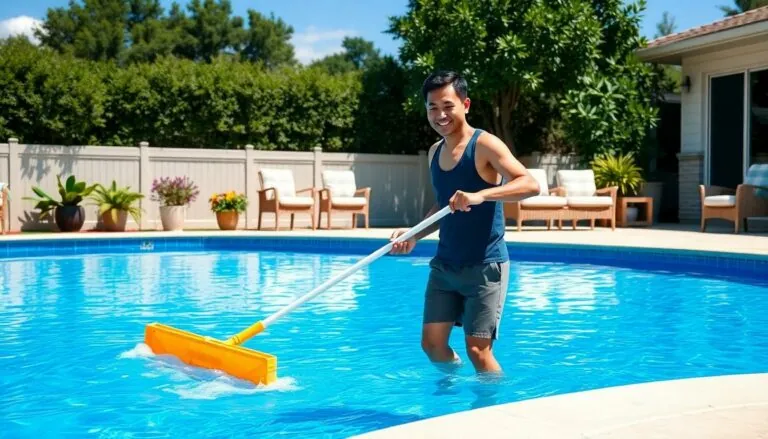Table of Contents
ToggleDiving into the world of salt water pools can feel like stepping into a refreshing oasis, but don’t let that calm surface fool you. Maintaining a salt water pool is a bit like training a puppy: it looks easy, but there are a few tricks to keep things running smoothly. With the right know-how, even beginners can turn their backyard into a sparkling paradise without losing their sanity—or their swim trunks.
Understanding Salt Water Pools
Salt water pools use a different approach to maintain water quality compared to traditional chlorine pools. The system generates chlorine through a process called electrolysis, where salt in the water undergoes a chemical reaction.
How Salt Water Pools Work
Salt water pools contain a salt cell that converts dissolved salt into chlorine. This process helps maintain consistent chlorine levels. The concentration of salt is lower than that of seawater, making the water feel softer and more pleasant to the skin. As the system works, it continuously replenishes chlorine, reducing the need for manual addition. Properly balanced, the water remains sanitized, minimizing the risk of algae and bacterial growth.
Benefits of Salt Water Pools
Salt water pools offer several advantages over traditional pools. They require less maintenance due to the self-regulating chlorine generation. Users often enjoy softer water, providing a more comfortable swimming experience without the harshness of conventional chemicals. Reduced chlorine usage impacts chemical costs and promotes a healthier environment. Additionally, salt water pools can lead to longer equipment lifespans and lower chemical exposure for swimmers.
Essential Equipment for Maintenance

Essential equipment plays a vital role in maintaining salt water pools. Having the right tools simplifies upkeep and ensures an enjoyable swimming experience.
Chlorine Generator
Chlorine generators convert salt into chlorine through electrolysis. This process keeps chlorine levels consistent while reducing the need for manual additions of traditional chlorine products. Regular maintenance of the chlorine generator, including cleaning the salt cell, ensures optimal performance and efficiency. Detecting any signs of defects promptly enhances pool sanitation. Replacing worn-out parts contributes to the longevity of the generator and the overall pool system.
Pool Pump and Filter
Pool pumps and filters work together to circulate and purify water effectively. A reliable pump moves water through the filtration system, removing debris and contaminants. Regularly monitoring the pump’s performance prevents issues like clogging or excess wear. Filters should be cleaned according to the manufacturer’s recommendations to maintain water clarity. Maintaining these components guarantees balanced water chemistry and a comfortable swimming environment.
Regular Maintenance Tasks
Regular maintenance tasks are essential for keeping a salt water pool clean and enjoyable. Routine care ensures optimal water quality and a pleasant swimming experience.
Testing Water Chemistry
Testing water chemistry plays a critical role in maintaining a salt water pool. Test strips or liquid test kits provide insight into pH, alkalinity, and chlorine levels. Weekly tests help ensure balanced water chemistry, preventing algae growth and potential damage to the pool system. A pH level between 7.2 and 7.8 promotes swimmer comfort and equipment efficiency. Alkalinity should remain between 80 and 120 parts per million (ppm) to stabilize pH levels. Chlorine levels must stay between 1 and 3 ppm for effective sanitation. Regular testing provides peace of mind, contributing to a safer swimming environment.
Cleaning the Pool
Cleaning the pool keeps it inviting and hygienic. Skimming the surface daily removes leaves and debris before they sink. Brushing pool walls and tiles once a week prevents dirt buildup and promotes clarity. Vacuuming the pool at least once a week maintains cleanliness, especially in corners where debris tends to accumulate. Filters also require regular maintenance; backwashing or cleaning them monthly ensures efficient circulation. Regular upkeep prevents complications, keeping the water clear and enjoyable for swimmers.
Seasonal Maintenance Tips
Seasonal maintenance for salt water pools ensures water quality and equipment longevity.
Preparing for Winter
Winter preparation for salt water pools involves several key steps. Start by reducing the water level to below the skimmer to prevent freeze damage. Next, clean the pool thoroughly by skimming debris and vacuuming the bottom. Disconnect and winterize the chlorine generator, according to the manufacturer’s instructions. Additionally, cover the pool with a high-quality winter cover to keep out debris. After that, check and secure all equipment, ensuring it’s protected from harsh winter conditions. These actions help maintain the pool and ready it for the following swim season.
Spring Start-Up Procedures
Spring start-up procedures for salt water pools require careful attention. Begin by removing the winter cover and cleaning it before storage. Next, clean the pool’s walls and floor, ensuring it’s free from debris. Refill the pool to the proper water level, if necessary, then power on the filtration system. Afterward, test the water chemistry, focusing on pH, alkalinity, and chlorine levels to ensure they are balanced. Next, inspect and clean the chlorine generator and other equipment, ensuring optimal performance. These steps rejuvenate the pool for a vibrant spring season ahead.
Common Issues and Troubleshooting
Maintaining a salt water pool involves addressing common issues. Troubleshooting these problems ensures a clean and enjoyable swimming environment.
Algae Growth
Algae growth can be a persistent problem in salt water pools. High water temperatures and imbalanced chemical levels often promote its development. To combat this, regularly test and adjust pH and chlorine levels. Maintaining optimal chlorine levels can help prevent algae from taking hold. If algae is present, a shock treatment with chlorine can effectively eliminate it. Additionally, ensuring proper circulation from pumps and regularly brushing pool surfaces can reduce the chances of its recurrence.
Equipment Malfunctions
Equipment malfunctions may occur despite regular maintenance. Common issues include salt cell failure or pump malfunction. Faulty salt cells may result from scaling or improper water chemistry, requiring cleaning or replacement. If circulation issues arise, check the pump for clogs or leaks. Filters may also need cleaning or replacement to ensure optimal water flow. Monitoring equipment performance regularly helps anticipate problems before they escalate, ensuring a smoothly running system.
Maintaining a salt water pool may seem daunting at first but with the right approach it becomes manageable and rewarding. By understanding the unique needs of salt water systems and implementing regular maintenance routines beginners can ensure a clean and enjoyable swimming environment.
Investing time in learning about water chemistry and equipment care pays off in the long run. With a little patience and effort anyone can create a serene oasis that enhances their outdoor space. Embracing the benefits of salt water pools not only promotes a healthier swimming experience but also simplifies maintenance tasks, making it a worthwhile endeavor for any pool owner.




